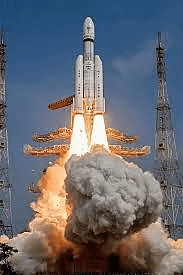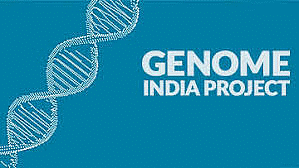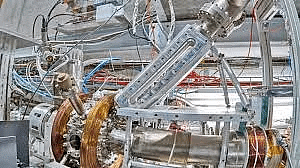Science and Technology: March 2024 Current Affairs | Current Affairs: Daily, Weekly & Monthly - CLAT PDF Download
New Satellite-Based Toll Collection System

Why is the News?
The Ministry of Road Transport and Highways of India has recently announced in Parliament the intention to introduce a new highway toll collection system before the 2024 election's model code of conduct takes effect.
What is the Proposed New Highway Tolling System?
- Utilization of GNSS: The system relies on the Global Navigation Satellite System (GNSS), including India's GAGAN (GPS Aided GEO Augmented Navigation), for precise location tracking.
- Comprehensive Satellite Navigation: GNSS encompasses various satellite-based navigation systems, such as the US' GPS, providing enhanced accuracy and global coverage.
- On-Board Unit Integration: Vehicles will be equipped with an On-Board Unit (OBU) or tracking device, communicating with satellites to determine their location.
- Digital Image Processing: National highways' coordinates are captured through digital image processing, facilitating toll calculation based on traveled distance.
- Digital Wallet Integration: Toll payments will be deducted from a linked digital wallet on the OBU, ensuring seamless and cashless transactions.
- Enforcement Measures: CCTV-equipped gantries along highways will monitor compliance and deter evasion tactics.
- Coexistence with FASTag: Initially, the system will run alongside the existing FASTag-based toll collection, with a decision pending on mandating OBUs for all vehicles.
Benefits
- Enhanced Traffic Flow: Removal of toll plazas is expected to alleviate traffic congestion, particularly during peak hours.
- Accelerated Commutes: Hassle-free toll collection should result in faster travel times and an optimized highway network.
- Equitable Billing: Users will only pay tolls for the distance traveled, promoting a fair pay-as-you-use model.
Challenges
- Payment Recovery: Addressing concerns related to toll recovery from users with depleted digital wallets or those attempting to manipulate the system.
- Enforcement Infrastructure: Establishing a nationwide network of Automatic Number-Plate Recognition (ANPR) cameras necessitates substantial infrastructure development.
- Privacy Considerations: Ensuring robust data security and protecting user privacy are critical aspects that require attention.
India’s 5G Fighter Aircraft and LCA Tejas

Overview
The Defence Research and Development Organisation (DRDO) recently achieved a successful maiden flight test of the Power Take Off (PTO) Shaft on the Light Combat Aircraft (LCA Tejas) Limited Series Production (LSP) -3 aircraft in Bengaluru.
About LCA Tejas
- It stands out as the lightest, smallest, and tailless multi-role supersonic fighter aircraft in its category.
- Designed to carry a variety of air-to-air and air-to-surface precision-guided weapons, it boasts air-to-air refueling capability.
- The Tejas can handle a maximum payload of 4000 kg and reaches speeds of up to Mach 1.8.
Key facts about the Power Take Off (PTO) shaft
- The PTO shaft is an indigenous creation developed by the Combat Vehicles Research & Development Establishment (CVRDE), Chennai, a division of the Defence Research and Development Organisation (DRDO).
- Employing a patented 'Frequency Spanning Technique,' it's designed to navigate different engine speeds effectively.
- This lightweight, high-speed, lubrication-free shaft transmits increased power between the aircraft engine gearbox and the Aircraft Mounted Accessory Gearbox while accommodating misalignments in the drive line.
Multiple Independently Targetable Re-entry Vehicle Technology

Why in News?
India has recently achieved a notable milestone in missile technology, joining the esteemed group of nations with Multiple Independently Targetable Re-entry Vehicle (MIRV) capabilities. This feat was accomplished through the successful flight test named Mission Divyastra conducted by the Defence Research and Development Organisation (DRDO), marking the integration of MIRV technology into the indigenously developed Agni-5 missile for the first time.
What are the Key Facts About MIRV Technology?
Inception
- MIRV technology traces its origins to the United States in 1970, with the deployment of a MIRVed Intercontinental Ballistic Missile (ICBM).
- This technology empowers a single missile to carry multiple warheads (typically 3-4), each capable of targeting distinct locations independently.
- Enhancing the missile's efficacy, MIRVs expand the number of potential targets it can engage.
- They can be launched from both land-based and sea-based platforms, including submarines, augmenting operational flexibility and range.
Global Adoption and Proliferation
- Nations possessing MIRV technology encompass major nuclear powers like the United States, the United Kingdom, France, Russia, China, and India, with Pakistan conducting a test (Ababeel Missile) in 2017.
- The test flight of Agni-5 marked India's debut in MIRV technology testing, aimed at deploying multiple warheads at various locations in a single launch.
- Equipped with indigenous avionics systems and high-accuracy sensor packages, the Agni-5 weapon system ensured the re-entry vehicles reached target points with desired precision.
Strategic Significance
- Initially designed to bolster offensive capabilities rather than counter ballistic missile defenses, MIRVs' capacity to deploy multiple warheads independently poses a formidable challenge for defense systems compared to conventional missiles.
Challenges
- Deploying MIRV technology presents intricate challenges, including warhead miniaturization, advanced guidance system development, and ensuring individual re-entry vehicle reliability.
- Overcoming these hurdles is imperative to uphold the efficacy and dependability of MIRV systems in strategic operations.
New Rocket Launchport in Tamilnadu

In the News
The Prime Minister recently inaugurated the foundation stone laying ceremony of ISRO’s second rocket launchport at Kulasekarapattinam.
About Kulasekarapattinam
- This launchport, costing Rs 986 crore and strategically situated in Tamil Nadu’s Thoothukudi district, will primarily facilitate commercial, on-demand, and small satellite launches in the future.
- It will be the second launchport after the Satish Dhawan Space Centre (SHAR), established in Andhra Pradesh’s Sriharikota in 1971, boasting two launch pads.
- Focusing on Small Satellite Launch Vehicles (SSLVs) on a commercial basis, it aims to launch 24 satellites annually utilizing a mobile launch structure.
- Its strategic positioning allows for fuel-saving launches directly south over the Indian Ocean, bypassing the need to traverse landmasses.
Need for Such Facility
- Fuel Saving: In contrast to the Satish Dhawan Space Centre, where rockets require a curved path southward to avoid Sri Lanka’s landmass, Kulasekarapattinam's location reduces fuel requirements for small rocket launches.
- Unburdening SHAR: The burgeoning demand for commercial launches necessitates the establishment of a second launchport to alleviate pressure on the Satish Dhawan Space Centre (SDSC) SHAR in Sriharikota.
- Dedicated Launch for Small Payloads: While SHAR handles larger missions, Kulasekarapattinam launchport will focus exclusively on smaller payloads, including commercial and on-demand launches.
Geographical Advantages
- Strategic Location: Kulasekarapattinam's natural positioning offers an advantageous launch site for ISRO’s future endeavors, particularly for the SSLV, owing to its geographical, scientific, and strategic significance.
- Optimized Trajectory: Launches from Kulasekarapattinam follow a direct southward trajectory, minimizing fuel consumption compared to SHAR's longer trajectories.
SSLVs: Purpose and Development
- Small Satellite Launch Vehicle (SSLV): Designed for launching small satellites weighing between 10 to 500kg into Low Earth Orbit, SSLV caters to commercial and on-demand launches.
- Mission Successes: While SSLV-D1's launch in August 2022 fell short of achieving the intended orbit, SSLV-D2's success in February 2023 marked a significant milestone for ISRO’s SSLV program.
Carbon Footprint of Artificial Intelligence
Context
AI has a large carbon footprint due to the energy needed to train and run complex models.
AI’s Role in Climate Change
- Dual Nature: AI's impact on climate change can be both beneficial and detrimental due to its substantial energy requirements.
- Source of Emissions: Emissions from AI result from the infrastructure needed to construct and operate data centers, particularly during the training and inference phases of AI systems.
- Energy-Intensive Processes: The training and operation of AI models, especially large artificial neural networks (ANNs), demand significant computing power, leading to high CO2 emissions.
Carbon Footprint of AI
- Example of GPT-3: The training of GPT-3 generated 502 metric tonnes of carbon emissions, equivalent to the annual emissions of 112 petrol cars, with an additional 8.4 tonnes of CO2 emitted annually during inference operations.
- Growing Energy Requirements: Since the early 2010s, the energy demands of AI systems, including large language models like ChatGPT, have surged by 300,000 times, posing a substantial CO2 emission risk.
Innovative Solutions for Reducing AI’s Carbon Footprint
- Spiking Neural Networks (SNNs):
- Energy Efficiency: SNNs provide an energy-efficient alternative to ANNs by replicating neural activity in the brain, with energy consumption occurring only during spike events.
- Operational Efficiency: SNNs have the potential to be 280 times more energy-efficient than ANNs due to their binary, spike-based communication method, making them suitable for energy-constrained applications.
- Lifelong Learning (L2):
- Minimizing Retraining: L2 addresses the issue of knowledge forgetting in ANNs by enabling sequential learning on new tasks without extensive retraining, thereby reducing AI's energy consumption over its lifespan.
Future Directions and Technological Advances
- Smaller AI Models: Developing smaller yet equally capable AI models can mitigate energy demands.
- Quantum Computing: This emerging technology holds promise for revolutionizing AI's energy efficiency by enabling faster training and inference, potentially at a lower energy cost.
Genome India Project

Why is the News?
The Government aims to sequence 10,000 genomes by the end of 2023 through the Genome India Project (GIP).
- The Department of Biotechnology, Ministry of Science and Technology has already sequenced nearly 7,000 genomes, with 3,000 of them available for public access.
What is the Genome India Project?
Need:
- India's population comprises over 4,600 diverse population groups, many of which are endogamous, leading to unique genetic variations and disease-causing mutations.
- Creating a database of Indian genomes can help researchers understand these unique genetic variants for personalized drugs and therapies.
- Comparable projects in the UK, China, and the US aim to sequence at least 100,000 genomes.
About:
- Inspired by the Human Genome Project, the Genome India Project started in 2020 to understand genetic variations and disease-causing mutations specific to the Indian population.
- It involves sequencing and analyzing genomes to gain insights into genetic causes of diseases and develop personalized therapies.
- Led by the Centre for Brain Research at the Indian Institute of Science, Bangalore, the project collaborates with 20 institutions across India.
What is the Significance of the GIP?
Precision Healthcare:
- GIP aims to develop personalized medicine based on patients' genomes to predict and manage diseases more effectively.
- Mapping disease propensities to genetic variations can enable targeted interventions and early disease anticipation.
- For instance, genome variations may explain why cardiovascular disease manifests differently in different populations.
Sustainable Agriculture:
- Understanding the genetic basis of plant susceptibility can enhance agriculture by reducing dependence on chemicals.
International Cooperation:
- The project benefits global science by mapping one of the world’s most diverse gene pools.
- Its scale and diversity make it one of the most significant genetic studies globally.
What are the Challenges?
- Scientific Racism: Concerns arise about potential scientific racism and reinforcement of stereotypes based on heredity. Similar studies in the past have been misused to justify discrimination.
- Data Privacy: Questions arise about data privacy and storage, especially in the absence of comprehensive data privacy laws in India.
- Ethical Concerns: The project raises ethical questions regarding private gene modification or selective breeding, exemplified by the 2020 gene-editing scandal in China.
Way Forward
- GIP should be conducted with adequate safeguards to ensure ethical and privacy standards are upheld.
- While promising for biotechnology, agriculture, and healthcare, the project requires careful consideration to address privacy concerns and prevent data misuse.
 |
Download the notes
Science and Technology: March 2024 Current Affairs
|
Download as PDF |
Claude 3 AI Chatbot
Why in News?
Anthropic, an AI startup, recently unveiled its latest family of AI models named Claude 3, claiming to set new industry standards across various cognitive tasks.
What is Claude 3?
About Claude:
- Claude comprises Large Language Models (LLMs) developed by Anthropic, specialized in understanding and generating human-like text.
- The chatbot can handle text, voice messages, and documents, providing contextual responses efficiently.
Training:
- Claude is trained using data from the Internet and licensed datasets through Supervised Learning (SL) and Reinforcement Learning (RL).
- In the SL phase, responses are self-assessed based on guiding principles, aiming to mitigate harmful outputs.
- The RL phase involves training based on AI-generated feedback, aligning responses with constitutional principles to ensure helpfulness and harmlessness.
Claude 3:
- The Claude 3 family consists of three models: Claude 3 Haiku, Claude 3 Sonnet, and Claude 3 Opus, each with increasing capabilities.
- Claude 3 Opus is the most powerful, Claude 3 Sonnet is capable and competitively priced, and Claude 3 Haiku is suited for instant responses.
- Claude Sonnet powers the Claude.ai chatbot for free, while Opus is accessible through Anthropic's web chat interface for subscribers to Claude Pro.
Limitations of Claude 3:
- Claude 3 excels in tasks like factual questions and optical character recognition (OCR) but faces challenges in complex reasoning and mathematical problems.
- Although proficient in tasks like writing Shakespearean sonnets, it exhibits biases in responses, favoring certain racial groups.
Obelisks
Context
A recent discovery by a team at Stanford University has unveiled a new type of biological entity called obelisks, found in large numbers within the human mouth and gut.
These microscopic circular bits of genetic material self-organize into a rod-like shape and contain one or two genes.
About Obelisks
- Obelisks are situated somewhere between viruses and viroids, with a circular single-stranded RNA genome like viroids but containing genes that may code for proteins like viruses.
- Named obelisks due to their shape, they are distinct from known biological entities and have been overlooked until now.
- They are not rare and are present in around 7% of gut microbiome datasets and 50% of mouth datasets. Obelisks likely rely on microbial host cells, potentially bacteria or fungi, for replication.
Gene Therapy for Hemophilia A
Why is it in the News?
The Union Minister of Science & Technology recently announced during the National Science Day 2024 program that India conducted its inaugural human clinical trial of gene therapy for Hemophilia A (FVIII deficiency) at Christian Medical College (CMC) Vellore.
- The event also highlighted India's advancements in Science and Technology (S&T).
Understanding Hemophilia A
- Definition: Hemophilia refers to a rare group of bleeding disorders stemming from a congenital deficiency in specific clotting factors, with Hemophilia A being the most common type.
- Factor VIII Deficiency: Hemophilia A results from a deficiency in a crucial blood clotting protein called factor VIII, leading to prolonged bleeding after injuries due to delayed clotting.
- Causes: Hemophilia A is primarily inherited, following an X-linked recessive pattern, where the gene responsible for factor VIII production is located on the X chromosome.
- Symptoms: Severity varies depending on factor VIII activity, with common symptoms including easy bruising, excessive bleeding from minor injuries, bleeding in joints causing pain and swelling, and bleeding after surgeries or dental procedures.
- Treatment: Current treatments involve replacing the missing clotting factor, typically through injection of clotting factor concentrates, derived either from human plasma or via recombinant DNA technology. Gene therapy is also emerging as a promising treatment method.
- Acquired Hemophilia A: While typically inherited, Hemophilia A can also be acquired later in life due to auto-antibodies targeting factor VIII, known as acquired hemophilia A.
What is National Science Day?
- Significance: Celebrated on 28th February annually, National Science Day commemorates the discovery of the ‘Raman Effect’ by Sir Chandrasekhara Venkata Raman in 1928, which led to his Nobel Prize in 1930. The Raman Effect enables material identification based on light scattering.
- Purpose: The day aims to promote scientific temper, popularize science, encourage innovative activities, and foster a positive research culture.
- Theme for 2024: 'Indigenous Technologies for Viksit Bharat.'
Recent Advancements in India's Science and Technology
- India has become the world's third-largest startup ecosystem with over 100 unicorns, demonstrating significant entrepreneurial growth.
- The bio-economy sector has seen a remarkable 13-fold increase over the past decade, reaching USD 130 billion in 2024.
- India ranks among the top five countries for scientific research publications and holds the 40th position in the Global Innovation Index (GII), underscoring its dedication to innovation.
- Initiatives like the Aroma Mission and Purple Revolution have transformed agriculture, nurturing a thriving community of agri-startups.
- The development of Maya OS by the Indian Defence Research and Development Organisation has strengthened cybersecurity measures against online threats.
- India's intellectual property landscape is flourishing, with patent filings exceeding 90,000, marking the highest in two decades.
- The successful Chandrayaan-3 Mission showcases India's space exploration capabilities, paving the way for the historic Gaganyaan mission.
Laser Cooling of Positronium

Why in News?
The AEgIS collaboration has made a noteworthy breakthrough by demonstrating laser cooling of Positronium.
- This experiment took place at the European Organisation for Nuclear Research, commonly known as CERN, situated in Geneva.
Key Highlights of the Study
About AEgIS:
- AEgIS stands for Anti-hydrogen Experiment: Gravity, Interferometry, Spectroscopy, and is a collaboration of physicists from several European countries and India.
- In 2018, AEgIS achieved a groundbreaking feat by becoming the first in the world to demonstrate the pulsed production of antihydrogen atoms.
Aim:
- This experiment serves as a crucial precursor to forming antiHydrogen and measuring Earth’s gravitational acceleration on antihydrogen in the AEgIS project.
- The achievement could potentially lead to the development of a gamma-ray laser, enabling researchers to probe inside the atomic nucleus, with applications extending beyond physics.
Positronium:
- Positronium consists of a bound electron and positron, forming a fundamental atomic system.
- As it comprises only leptons without nuclear matter, Positronium is unique.
- Its short lifespan of 142 nano-seconds and twice the electron mass make it highly unstable.
Choosing Laser Cooling:
- Positronium, being incredibly light and unstable, poses challenges for experimental studies due to its wide range of velocities.
- Laser cooling, proposed in 1988, involves particles absorbing and emitting photons to reduce temperature.
Laser Cooling:
- The experimentalists successfully cooled Positronium atoms from approximately 380 Kelvin to about 170 Kelvin using an alexandrite-based laser system.
Significance and Future Prospects:
- Laser cooling of Positronium facilitates spectroscopic comparisons essential for Quantum Electrodynamics (QED) investigations.
- Precise measurements of antimatter properties and gravitational behavior could uncover new physics and shed light on matter-antimatter asymmetry.
- The creation of a Bose-Einstein condensate of antimatter holds promise for both fundamental and applied research, including insights into the atomic nucleus.
The success of the AEgIS experiment in laser cooling Positronium represents a significant advancement in antimatter research at CERN, contributing not only to fundamental physics understanding but also holding potential for transformative discoveries and applications in the future.
|
1104 docs|674 tests
|
FAQs on Science and Technology: March 2024 Current Affairs - Current Affairs: Daily, Weekly & Monthly - CLAT
| 1. What is the significance of India's new satellite-based toll collection system? |  |
| 2. How does the Multiple Independently Targetable Re-entry Vehicle Technology work? |  |
| 3. What is the Genome India Project and its objectives? |  |
| 4. What are the potential applications of gene therapy for Hemophilia A? |  |
| 5. How does Laser Cooling of Positronium contribute to scientific research? |  |




























